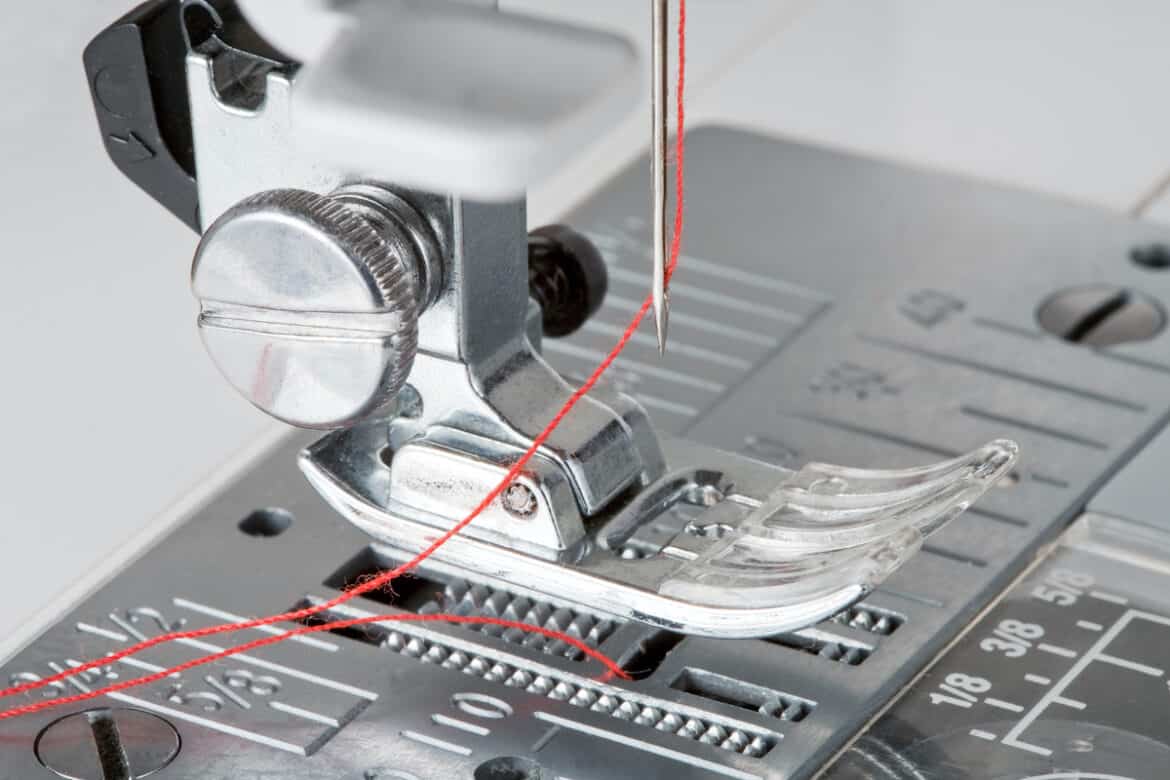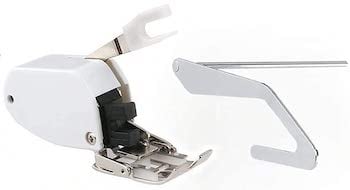Ever wanted to sew quilt-weight fabric, but your regular presser foot isn’t quite up to the task? Maybe you have a super slippery knit and are having a hard time getting things lined up, or you have a knit that stretches and your sewing machine can’t keep up?
Well, in all these situations, it’s best to start using a walker foot!
What is a walker foot for sewing? The walker (or walking) foot is an extra hooded presser foot that gives you even more control over your sewing, which will make sewing with tricky fabrics or multiple layers of fabric much easier.
In this article, we’ll take a look at the walking foot and how you can effectively use it in your next sewing project.
What Is A Walking Foot?
Before we can talk about the walking foot, you first need to know how your sewing machine functions and what makes a walking foot different than other kinds of presser feet. Have a look at your sewing machine, and you’ll see that underneath the presser foot, there is a set of ‘teeth’ – usually three sets.
These are called ‘feed dogs,’ and their job is to pull your fabric forward automatically while you sew, so you don’t have to pull your fabric while feeding it through the machine.
Now, imagine if you are working with multiple layers of fabric (such as when you are quilting) or sewing with extra slippery fabric.
The bottom set of feed dogs alone won’t be able to support all the layers of fabric, and your fabric will end up misaligned or bunched up because the feed dogs cannot carry the fabric forward to match the speed of the sewing machine.
This is a very common issue if you are sewing with heavy or slippery fabrics such as leather and denim or if you are working with multiple layers of fabrics, such as in quilting.
This is where the walking foot will come in. The walking foot is equipped with its own set of feed dogs that are attached to the metal bed of the sewing machine. The walking foot’s top feed dogs help move the top layer of fabric while the machine moves the bottom part of the garment. This eliminates the possibility of the layers of fabric shifting and puckering.
This helps pull the fabric through the machine so that the fabric is pulled forward with the bottom and the top feed dogs.
As you can imagine, the walking foot is superior to the regular presser foot in a few ways. A regular presser foot tends to push against the top of the fabric, which can prevent heavyweight fabrics from moving effectively as you sew. A walking foot can help avoid this issue by moving the fabric using the top feed dogs as well as the bottom.
To use the walking foot, make sure to position the walking foot’s movable bar on top of the machine’s needle bar. This way, the walking foot’s feed dogs will move in sync with the movements of the machine’s feed dogs and allow the walking foot to work correctly.
Walking Foot Options
When you shop for a walking foot for your sewing machine, you should know that there are two variations: the classic design and an open-toe design.
Both options do the job just fine, with one slight difference. The classic walking foot has a slightly ‘closed off’ presser foot, which is the same as the presser foot on your sewing machine. If you’re used to sewing with your machine’s regular presser foot, then this one’s not much different.
The open-toe walking foot has a wider presser foot with a gap at the bottom that allows you to easily see the stitches as the machine creates them. This design is great if you want to see your stitches, especially when you want to align the designs on your fabric or create stitch-in-the-ditch.
When To Use A Walking Foot
As we’ve mentioned, a walking foot is a great tool for quilters and sewers who love working with thick layers and tricky fabrics. However, that’s not its only application. A walking foot is useful to have in your toolkit in quite a few ways; let’s take a look at them below.
1. Matching Prints
When sewing a garment with a pattern or a directional print, matching the prints at the seams can make the final result look more professional and polished.
You can take all the time you have trying to pin the layers together, but with your machine’s regular presser foot, your prints can still become misaligned ever so slightly as you sew.
This is where the walking foot can help! It will make sure that the pieces align properly as you feed your layers through the sewing machine so that the prints will match perfectly as a result.
2. Sewing Stretchy Fabrics
Sketchy fabrics are difficult to sew with your regular presser foot. When you tug and pull the fabric, it will most definitely stretch and cause your stitches to become stretched out. This problem only becomes worse when you are sewing along the direction of the stretch, such as along the ribs of a knit fabric.
The walking foot is designed to counter this issue. Because both the top and the bottom sets of feed dogs will move the fabric on their own, you don’t have to pull on the fabric too much to guide it through the sewing machine.
This can make a world of difference when it comes to working with stretchy fabric, and the fabrics won’t stretch out as much when you sew, resulting in clean and even stitches.
3. Sewing Slippery Fabric
If you love working with delicate, slippery fabrics such as satin or silk, then you’ll love the walking foot as well!
Satin and silk feel lovely against the skin, but they are super slippery when you try to sew with them. To make matters worse, you can’t use sewing pins with these types of fabric because they are extremely delicate and can be damaged just from the sewing pins.
This is where a walking foot can do wonders for your project. It will prevent your layers of fabric from slipping around when you try to sew, by effectively moving the layers in unison using the feed dogs, so that your seams will be perfectly straight.
Because of this, a walking foot can make sewing with slippery fabrics much easier and more enjoyable.
4. Quilting
Quilting requires sewing together several layers of fabric and a thick batting layer. If you are using a regular presser foot, only the bottom layer can effectively move along as you sew, and the batting and the top layer can bunch up.
This is where the walking foot can really do wonders! As you move all the layers through the sewing machine, the walking foot can keep your layers aligned and well-controlled so that your designs will show up beautifully.
5. Topstitching Bindings And Hems
You’d think that topstitching bindings and hems are pretty simple, especially if the hems are pressed, right?
In most cases, topstitching is pretty straightforward. However, when sewing deep hems or a button placket, the slightest misalignment can really make your sewing look quite messy and uneven.
If you want a flatter result when you topstitch your hems and plackets, it’s best to use a walking foot to keep your layers aligned. That way, the result can lay flat and look more polished.
6. Sewing Over Bulky Seams
When sewing with bulky fabrics like denim, your seams can bulk up pretty quickly.
Your crotch seam, for example, will be pretty difficult to sew with a regular presser foot because it is made from 4 layers of denim laying on top of one another! You’ll end up with bunched-up and tangled threads that are definitely not fun to remove.
In this case, using a walking foot will allow you to ‘climb’ over the seam relatively unscathed, and your seam will look neater as well.
7. Matching Seam Intersections
When sewing sleeves or cuffs, it’s important for your seams to align to create a neat and polished line for your seam. Again, if your layers shift even just a little bit, your seams won’t align properly, and you’ll have to seam rip and start all over again.
If you want a precise alignment between your seams, it is best to use a walking foot to prevent the fabrics from shifting while you sew. This way, the seams will be perfectly aligned, and the result can be really satisfying!
When Not To Use A Walking Foot
While the walking foot is highly effective when sewing with tricky fabrics or sewing with multiple layers, using the walking foot is not recommended in the following cases.
- Sewing in reverse is not supported with the walking foot. The walking foot can only move forward, so if you want to go in reverse, it’s best to use a regular foot.
- Similarly, because the walking foot can only move forward, free-motion quilting or creating decorative stitches can be pretty tricky since the walking foot cannot move horizontally.
How To Use A Walker Foot For Sewing
So, now that you have a clearer picture about what a walking foot can do for you, you may be wondering how to use one. We’ve found a great tutorial from Howcast on YouTube explaining everything you need to know. Check it out below!
Up Next: What Is A Free Arm Sewing Machine?

